In this extract from his book 'Carn: The Game, and the Country that Plays it', Andrew Mueller charts the tumultous final years of Swans champion and dual Brownlow medallist Adam Goodes' career
Sydney 19.8.122 Carlton 9.8.62
Sydney Cricket Ground
ROUND 9, 2015
IN ALMOST every respect, this match was unremarkable: a sweatless belting by a home team, already certain finalists, of a visiting riff-raff with one win for the season to date, and little reason to expect many more. (Carlton duly won 2015's wooden spoon – quite a feat, considering that this necessitated being worse than Brisbane, which in 2015 was like being wetter than water.)
Sydney eased to a 63-point lead by three-quarter time, and lifted their boot off Carlton's neck a little in the final term, to win by an even 10 goals. Lance Franklin kicked seven for the Swans, but such was the disarray of the Blues' defence that there was little of the usual joy to be had from watching him, as one might admire a five-for by a champion fast bowler rather less if the opposition batsmen had been blindfolded and sent to the crease equipped with golf clubs.
Nevertheless, this Friday night non-event became the most ardently discussed, dissected and disputed game of 2015. It was the sucking core of a wildly whirling vortex of inanity, a peerless illustration of the paradox which holds that the more that modern media – and modern social media – examines something, the less anyone learns. It did at least acquire some utility as a reliable litmus test for the dickheadery levels of one's fellow citizens, whose views on the subject could reveal a great deal about them very quickly, usually unwittingly. And it nearly finished the career of one of the game's greatest players.
Adam Goodes in Sydney's 2015 Indigenous Round guernsey. All pictures: AFL Photos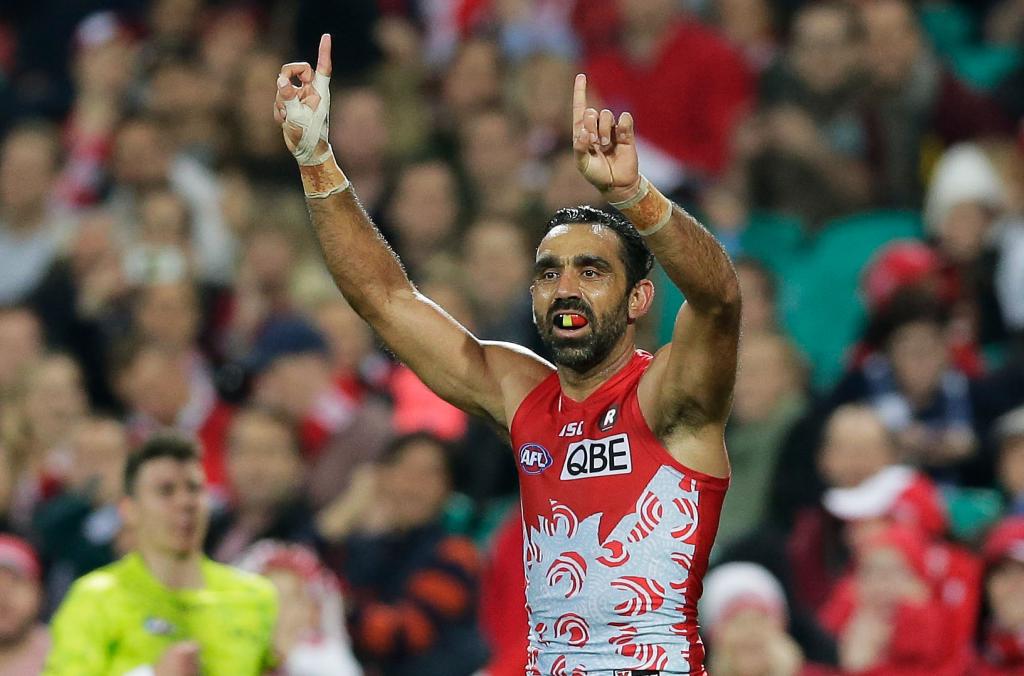
With about six-and-a-half minutes to play in the second quarter, Adam Goodes – dual Brownlow medallist, four-time All-Australian, 444 goals from 357 games to that point, not the sort of player teams other than the 2015 Blues tended to leave standing around on his own in the forward 50 – marked, unbothered, about 30 metres from the sticks, dead in front. Goodes goaled, putting Sydney 47 points ahead, 9.3 to 1.4. By way of celebration, he danced towards a terrace largely populated by Carlton barrackers, slapping his hands against his elbows, and finishing with a mime of a spear-carrying action, and a joyous battle whoop.
There was one sensible response to what Goodes did, and it was: an Indigenous player has kicked a goal during Indigenous Round, so he's doing an Indigenous dance – good on him. (Among the Carlton fans towards whom Goodes gambolled, while there was booing and gesturing, there was also laughter, and some applause which might not have been sarcastic.) However, non-sensible responses were not merely abundant, but at times almost impressive in their fatuity.
***
Even before round nine of 2015, there was history between Adam Goodes and that cohort of white Australians perturbed by any image of a triumphant and/or assertive black man. During Indigenous Round in 2013, Sydney played Collingwood at the MCG on a Friday night. Goodes conducted a masterclass, kicking three goals, gathering 30 possessions and earning three Brownlow votes as the Swans plucked the Magpies by 47 points. With about 90 seconds left on the clock, Collingwood's Darren Jolly chased the ball over the boundary line as Goodes chased him. As the pair drew up, outrun by the yellow Sherrin, Goodes' ear was caught by something over the fence. He turned around, called to a nearby steward, and pointed towards the source of whatever it was. As security escorted a girl draped in black and white from her seat, Goodes stalked across the field to the dressing-room, distraught, without waiting for the final siren, or the acknowledgements of his team's victory and his own best-on-ground performance.
There was one sensible response to what Goodes did, and it was: an Indigenous player has kicked a goal during Indigenous Round, so he's doing an Indigenous dance – good on him."
It emerged that Goodes had been called an 'ape', and that the spectator who had insulted him was a 13-year-old girl. Goodes' response was punctiliously gracious: he declined to press charges, accepted the culprit's apologetic phone call, and urged that no blame be assigned to her, nor media pursue her.
Goodes points out a young spectator, who it was later revealed had called the champion an 'ape'.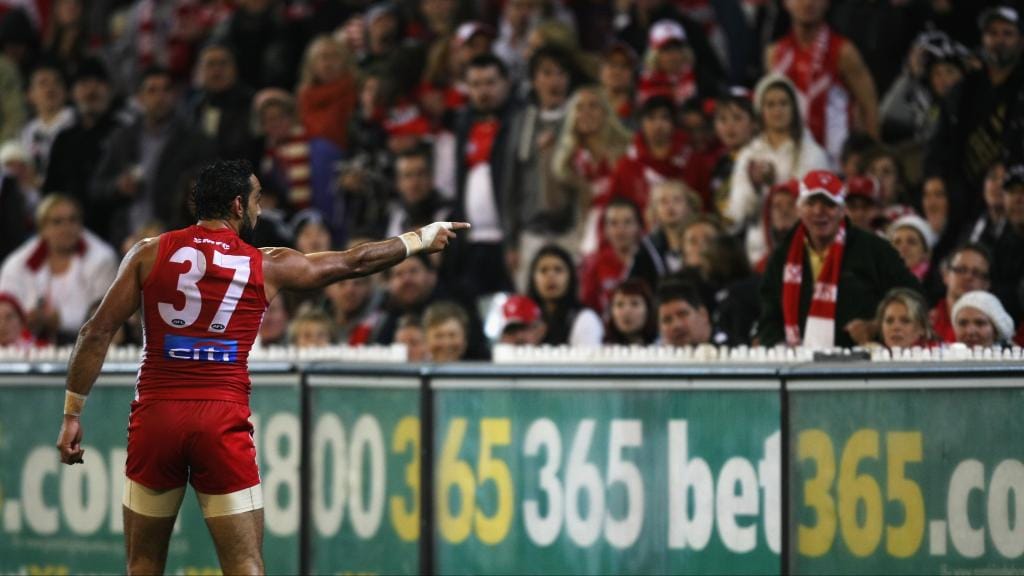
The responses of other AFL players, flickering across social media, were resoundingly sympathetic: Geelong's Joel Selwood, Richmond's Jack Riewoldt and West Coast's Nic Naitanui were among those who tweeted support for Goodes. Collingwood president Eddie McGuire visited the Swans' rooms after the match to apologise on behalf of his club.
***
It was far from the first instance of racial abuse of an Indigenous player, and it would not, lamentably, be the last. But it seemed like there were – with due recognition that this is a much, much easier thing for white folks to suggest – some grounds for optimism. At the instant the incident occurred, stewards, police, fellow players and League authorities alike unhesitatingly took the word, and the side, of the aggrieved Indigenous footballer – not a response which could have been anticipated for most of the game's history. There was general agreement that further education all round was required, though it is always worth wondering how many times Indigenous players can be expected to patiently talk everyone through the basics of not behaving like a goose at the football.
There were those unminded to help, largely well-rewarded white columnists and broadcasters with little experience of being called anything they didn't deserve. And there were, as there always are, angry morons on the internet, though their opinions merited no further consideration than usual. And there was, again, Eddie McGuire, who on the Wednesday morning following the match was co-hosting his Triple M show with former Western Bulldogs player Luke Darcy when the subject of a promo for King Kong, shortly to open at Melbourne's Regent Theatre, came up.
"Get Adam Goodes down for it, do you reckon?" said McGuire. "No, I wouldn't have thought so, absolutely not," replied a horrified Darcy, as if earnestly wishing that McGuire's seat was fitted with an ejector mechanism. McGuire wittered further in this vein, an aberration he later ascribed to tiredness and painkillers. Goodes declined to accept his apology.
(l-r) Eddie McGuire, Sam Newman and Jason Akermanis were among Goodes' most vocal critics.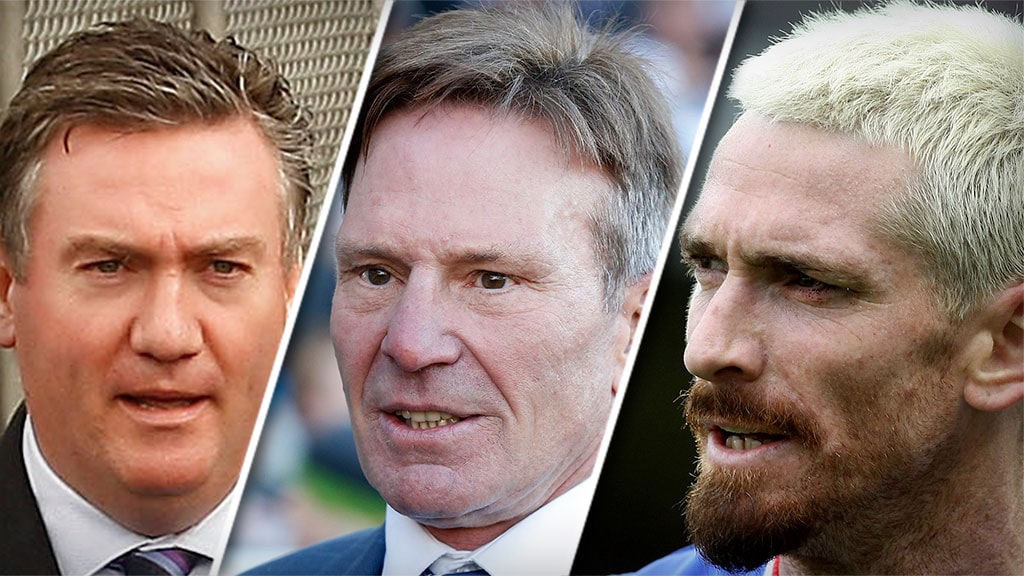
Those who had decided to dislike Adam Goodes as a consequence of this brouhaha did not have their mood improved by 2014. Goodes was garlanded Australian of the Year – for, among other things, his cofounding (with former Swans teammate Michael O'Loughlin) of the Go Foundation, an educational advocacy focusing on Indigenous youth. Goodes had a decent season on the field, as well, and it was no fault of his that Sydney were dismasted by Hawthorn in the 2014 Grand Final. But something was happening in the stands: Goodes was being booed.
***
Some defended this conduct, mostly that mystifying echelon of white people who presume to instruct black people in what does and does not constitute racism. They had, if one is extending greater generosity than their motivation merited, perhaps half a point. There are times when it is okay to boo a player, especially in the context of a match in which the player in question has perpetrated some malfeasance; it was fair enough, for instance, when Melbourne fans razzed Goodes during the 2007 game in which he took an unsavoury whack at Simon Godfrey. It's even sometimes okay to boo a player over a protracted period, when the player in question has chosen to play the pantomime villain. Jason Akermanis, one of those who (predictably) argued that Goodes was a big sook, or words to that effect, could only have assumed this role more obviously during his playing days if he'd turned out in a top hat, with a chuckling canine sidekick and curly waxed tips on the ends of his stupid moustache.
It is always worth wondering how many times Indigenous players can be expected to patiently talk everyone through the basics of not behaving like a goose at the football."
But this argument failed to acknowledge that when crowds persistently boo or otherwise insult a player, they are booing or otherwise insulting what that player represents. Adam Goodes consistently represented a refusal to pretend that rewarding a few dozen Aboriginal Australians for being good at football meant that everything else was okay.
Something was happening in the stands: Adam Goodes was being booed.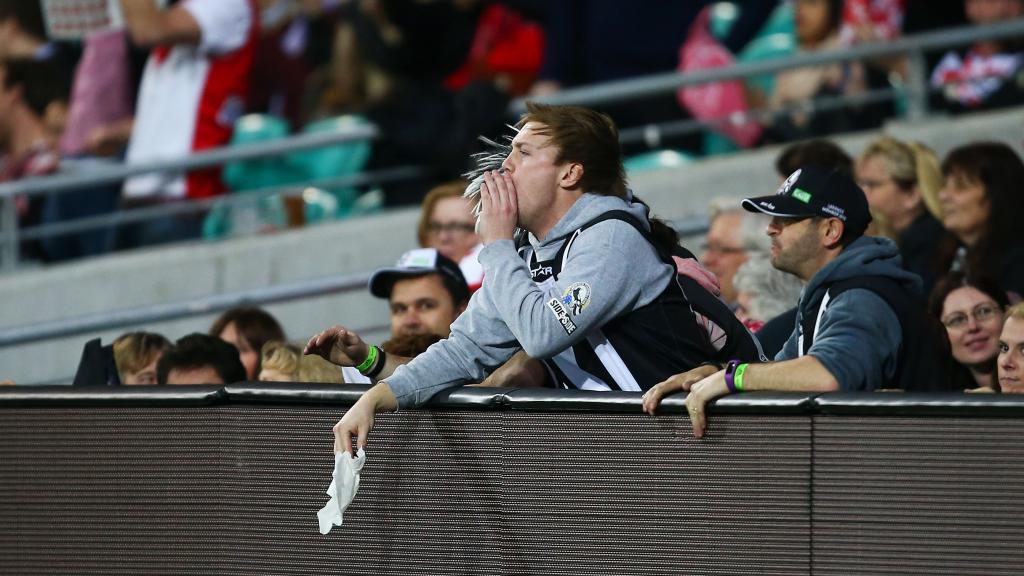
Such was the background racket when Carlton came to the SCG for Indigenous Round, 2015. Goodes and the Swans took the field wearing guernseys designed by Goodes' mother, Lisa Sansbury. Somewhere on his mind were the Under-16 Indigenous footballers of the Flying Boomerangs, whom he'd met during the week, and who'd taught him a war dance.
As he walked off after the game, Goodes was asked by Matthew Richardson, reporting for Fox Footy, if his celebration had been directed at the Carlton fans. "Not at all," replied Goodes. "Indigenous Round, proud to be Aboriginal, and representing." Over ensuing days, a number of good questions might have been asked about Goodes' caper – about its origins, its significance, the role of dance in Indigenous culture – but none were. Instead, the responses – certainly the loudest responses – clustered on that bracket of the spectrum between neurotic and idiotic. As calamitous mischance had it, Eddie McGuire was calling the game for Fox Footy. At half-time, he spluttered of Goodes' dance: "We've never seen that before. And I don't think we ever want to see it again, to be perfectly honest, regardless of what it is." He later dismissed Goodes' celebration as "a made-up dance, this is not something that has been going on for years". Others unsettled included Leigh Matthews, who saw it as provocation, and commentator Dennis Cometti, who upon further reflection was decent enough to admit, "I don't think I fully understood what that was all about" – a sentiment which should be less rare than it is.
***
Goodes played the following week against Gold Coast, and the week after against North Melbourne. Sydney won both games, and Goodes played well in both. When Sydney came back from the bye, Goodes was a bit off against Richmond, but so were the Swans. He kicked three goals in dispensing with Port Adelaide at the SCG, was solid in a win over Brisbane at the Gabba, and certainly wasn't among the Swans' worst as they got mowed by Hawthorn at Stadium Australia, nor when spanked by West Coast at Subiaco. But at the away games, there was no mistaking it: Goodes was being singled out, his every touch eliciting a low drone of derision.
Week after week, every touch by Goodes brought a drone of derision. 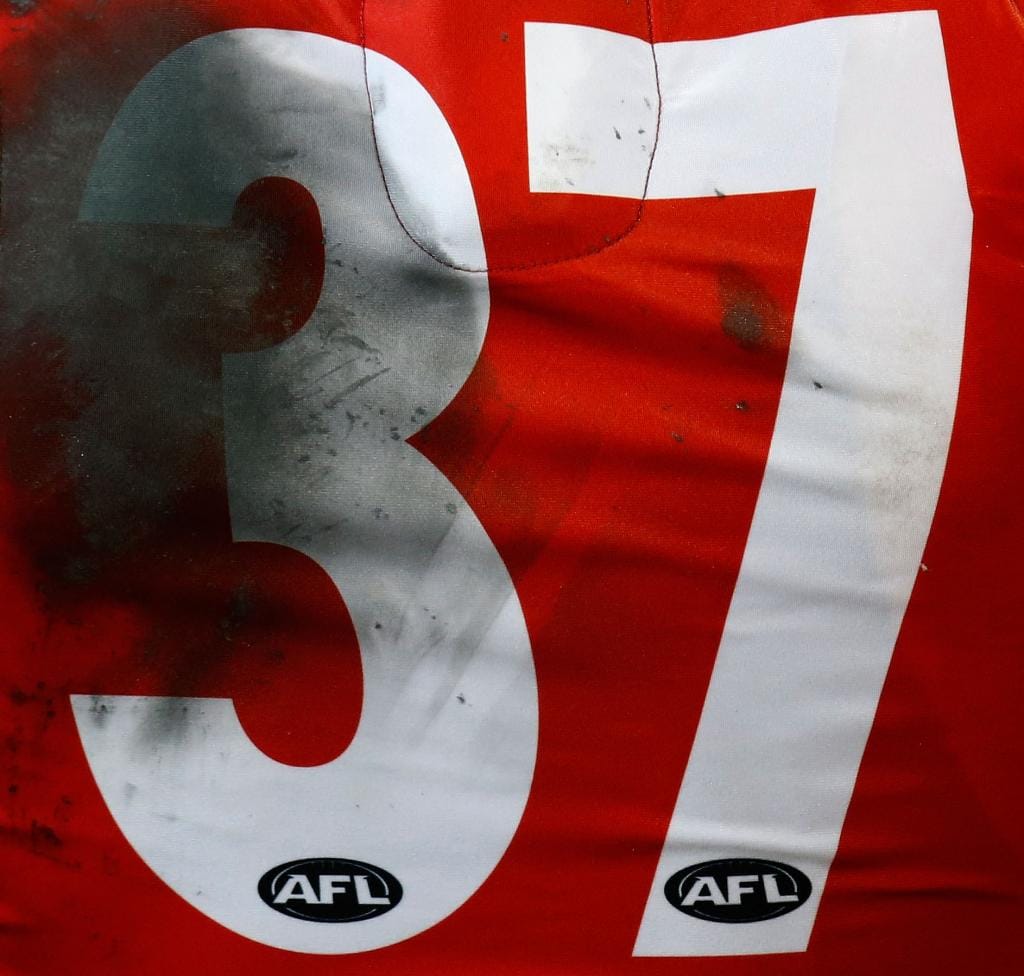
In the final quarter against the Eagles, the game more or less lost, Goodes' Indigenous teammate, Lewis Jetta, kicked a futile goal, and celebrated with a mimic of Goodes' dance. There was none of the exuberance of the original, though: Jetta was sour, angry, defiant.
A number of good questions might have been asked about Goodes' caper – about its origins, its significance, the role of dance in Indigenous culture – but none were."
It got to Goodes. He requested, and received, an indefinite leave of absence from the Swans. He would, at the very least, sit out the round 18 match at home to Adelaide; there were rumours that he might not play again. This prompted the expectable inanities from the usual suspects. Once it became clear that Jason Akermanis, Andrew Bolt, Miranda Devine, Alan Jones and Sam Newman were all on one side of an argument, that really should have been an end to it.
Goodes' performed his dance, he said, because he was 'proud to be Aboriginal, and representing'.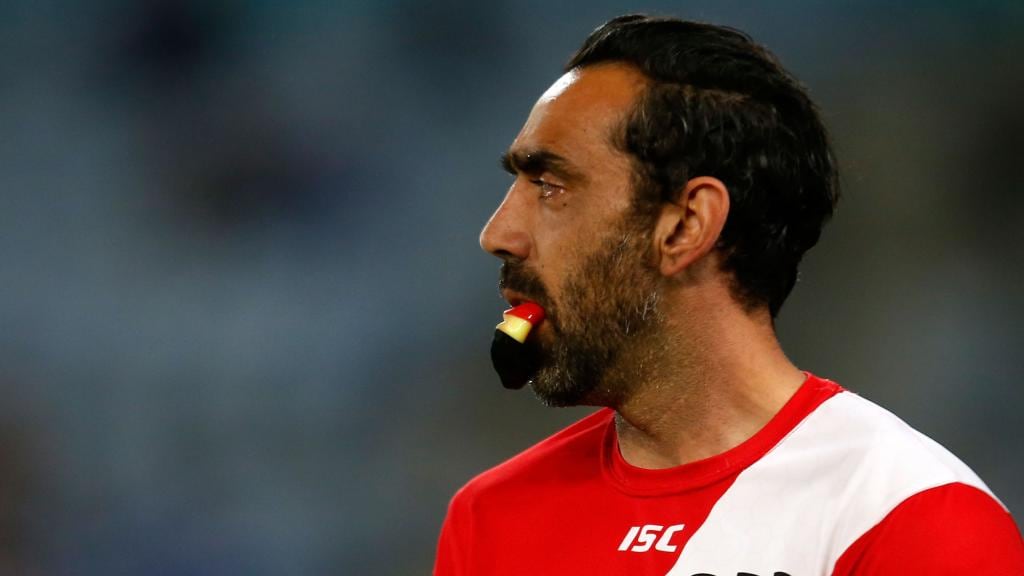
As round 18 approached, there were more demonstrations of support for Goodes. Many AFL players, Swans and not, Indigenous and not, defended Goodes' dance as inoffensive and/or kind of cool. The AFL Players' Association issued a statement backing Goodes. Writing in The Age, Western Bulldogs captain Bob Murphy correctly observed that "I can't talk on behalf of Adam or his people, nor would I want to" – if only such humility had been in more plentiful supply – "[but] every time I've heard the boos of this mob I've hung my head in despair, chin to chest. I suspect it's been the same for some players at every club in the AFL. There is no training or armour for those kinds of hits to the soul." More sensationally, the upper house of the New South Wales parliament unanimously passed a resolution, moved by Greens member Jeremy Buckingham, condemning Eddie McGuire for "being a continual boofhead".
Adam Goodes consistently represented a refusal to pretend that rewarding a few dozen Aboriginal Australians for being good at football meant that everything else was okay."
If round nine was Indigenous Round, round 18 became, for one year only, an unofficially declared Adam Goodes Round. At the SCG, supporters stood and applauded at the seven-minute mark of the third quarter, honouring Goodes' number, 37. Adelaide fans brought along an Indigenous flag, and directed all their booing at Kurt Tippett, who had departed the Crows for the Swans amid acrimony in 2012; he did not mend any fences by kicking three goals against his old club in the first quarter.
Many players and fans flocked to demonstrate their support for Goodes in round 18, 2015.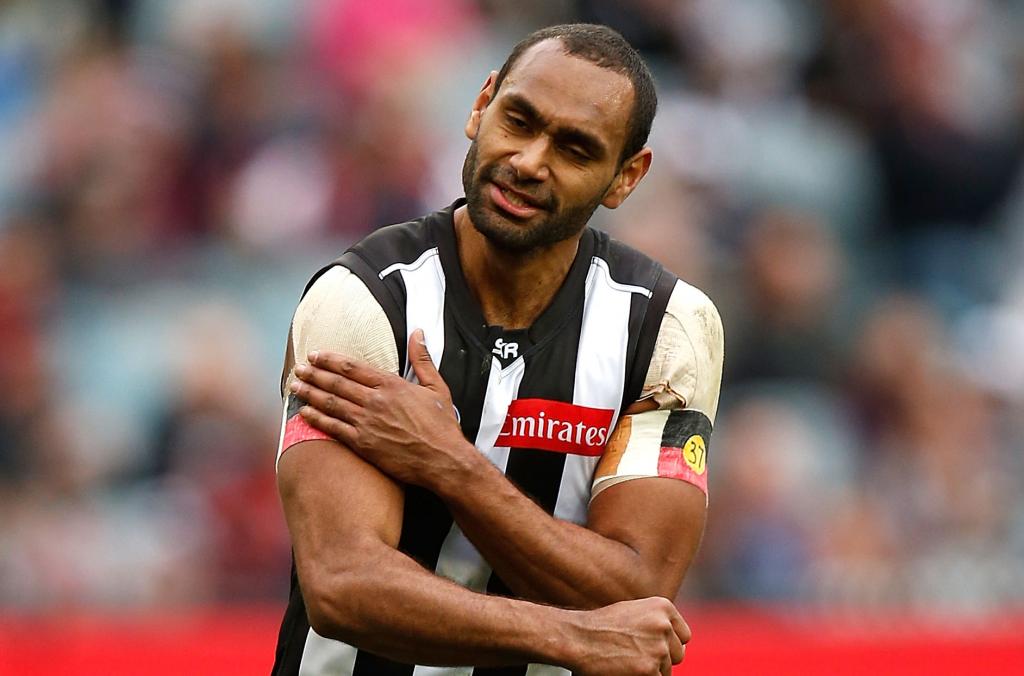
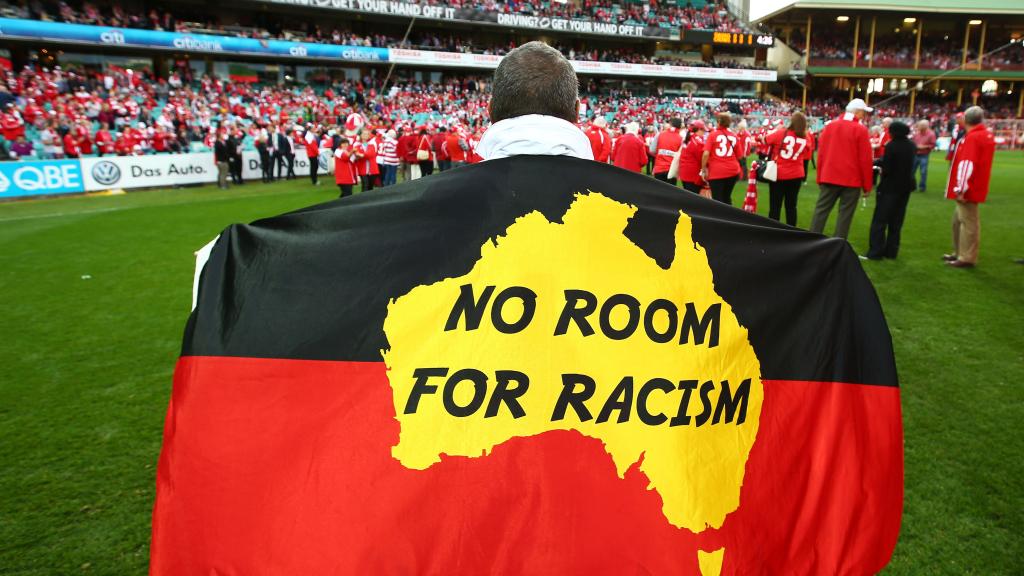
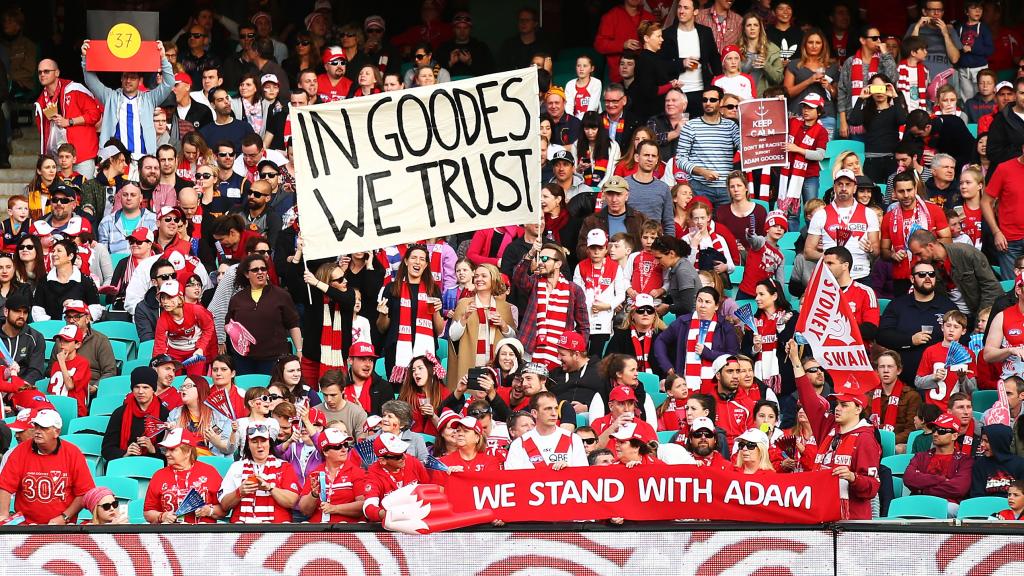
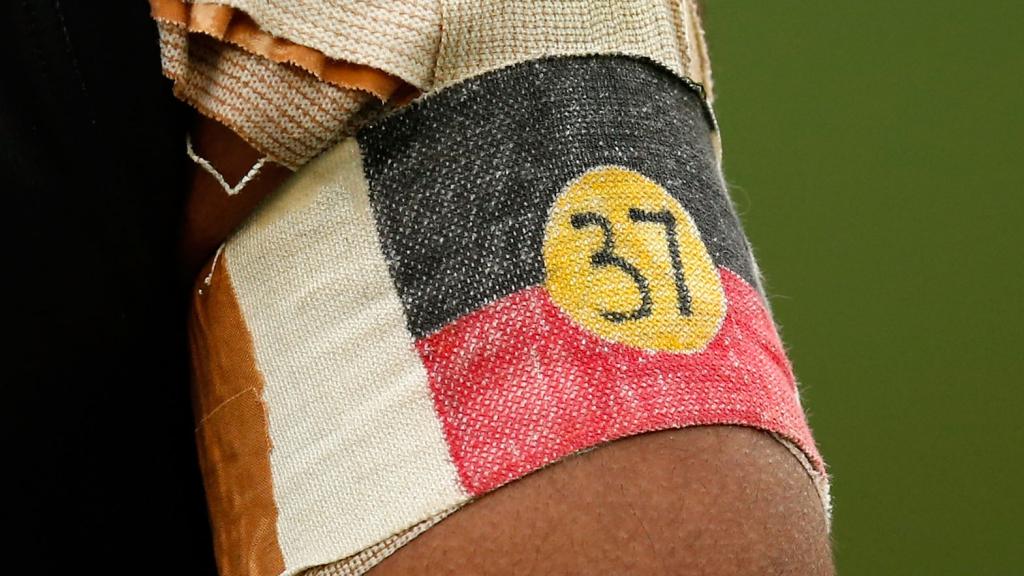
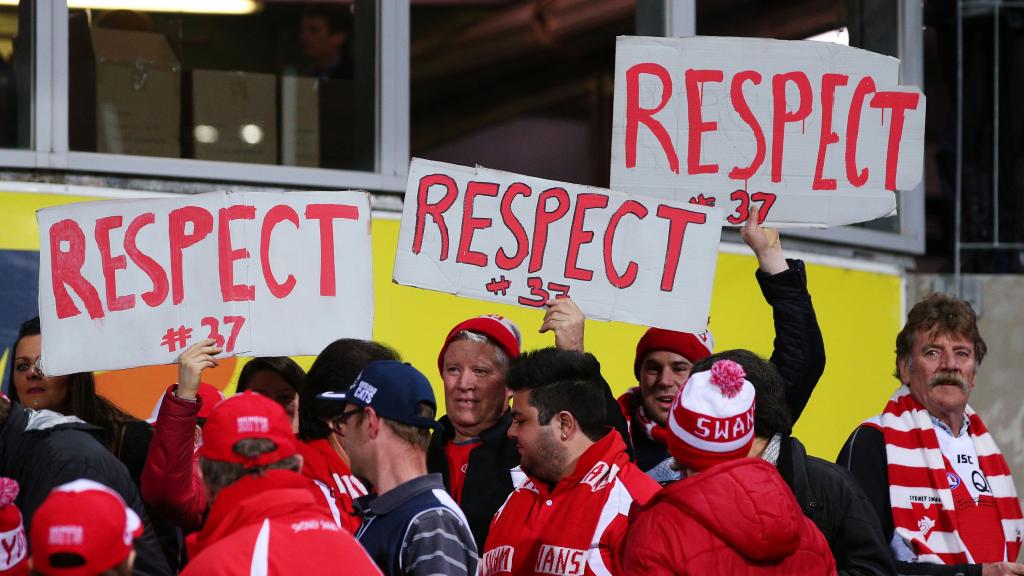
Elsewhere, Richmond, playing Hawthorn, and Western Bulldogs, playing Essendon, got their Indigenous Round guernseys out of the cupboard; Bob Murphy wore number 37 for the coin toss. Port Adelaide, hosting St Kilda, invited past Indigenous stars of both clubs – Nicky Winmar, Byron Pickett, Gavin Wanganeen – to greet the teams as they ran out. Other sports – the NRL, V8 Supercars – offered tributes to Goodes.
Some individual players, including Collingwood's Travis Varcoe and Melbourne's Heritier Lumumba and Nathan Jones, wore armbands or wristbands of red, black and gold. Around the League, Indigenous players who kicked goals celebrated in dance: Sydney's Lewis Jetta, Melbourne's Jeff Garlett, Fremantle's Michael Walters and Danyle Pearce. North Melbourne's Lindsay Thomas pulled aside his guernsey to reveal the Aboriginal flag tattooed on his chest. Heartened, Goodes returned the following week, as Sydney travelled to Geelong.
***
Geelong's hierarchy left no doubt about the reception they expected. Coach Chris Scott declared that anyone who booed Goodes would simply be outing themselves as a bigot. The teams were welcomed by a joint run-through bearing congratulations for Geelong captain Joel Selwood on his 200th game and Sydney's Luke Parker on his 100th, either side of a demand for 'Respect, Unity, Fairness'. Goodes' first touch, in a tussle with Jake Kolodjashnij, elicited only the clamour that might usually be expected, and his fine goal in the first quarter, slapping the ball from the hands of Geelong's Harry Taylor and scoring on the run, attracted no untoward jeering. By way of celebration, Goodes contented himself with high-fiving his teammates.
WE FAILED ADAM AFL, clubs unreservedly apologise to Goodes
Adam Goodes played out Sydney's season, which ended in a semi-final loss to North Melbourne. His decision to retire would normally have attracted the game's most fulsome tributes – he had played 372 games, a figure exceeded by just seven other players, and by no other Indigenous footballer. One of those tributes would have been participation in the traditional pre–Grand Final lap of honour for departing greats, but Goodes – as great a player as there has been – felt unable to take for granted the civility of the crowd, and declined the invitation. He might well have been right: a few weeks later, the department store David Jones unveiled Goodes as a brand ambassador, and its Facebook page was deluged with imbecilic vitriol.
Goodes ended his 372-game career at the end of 2015, but did not participate in the traditional Grand Final lap of honour.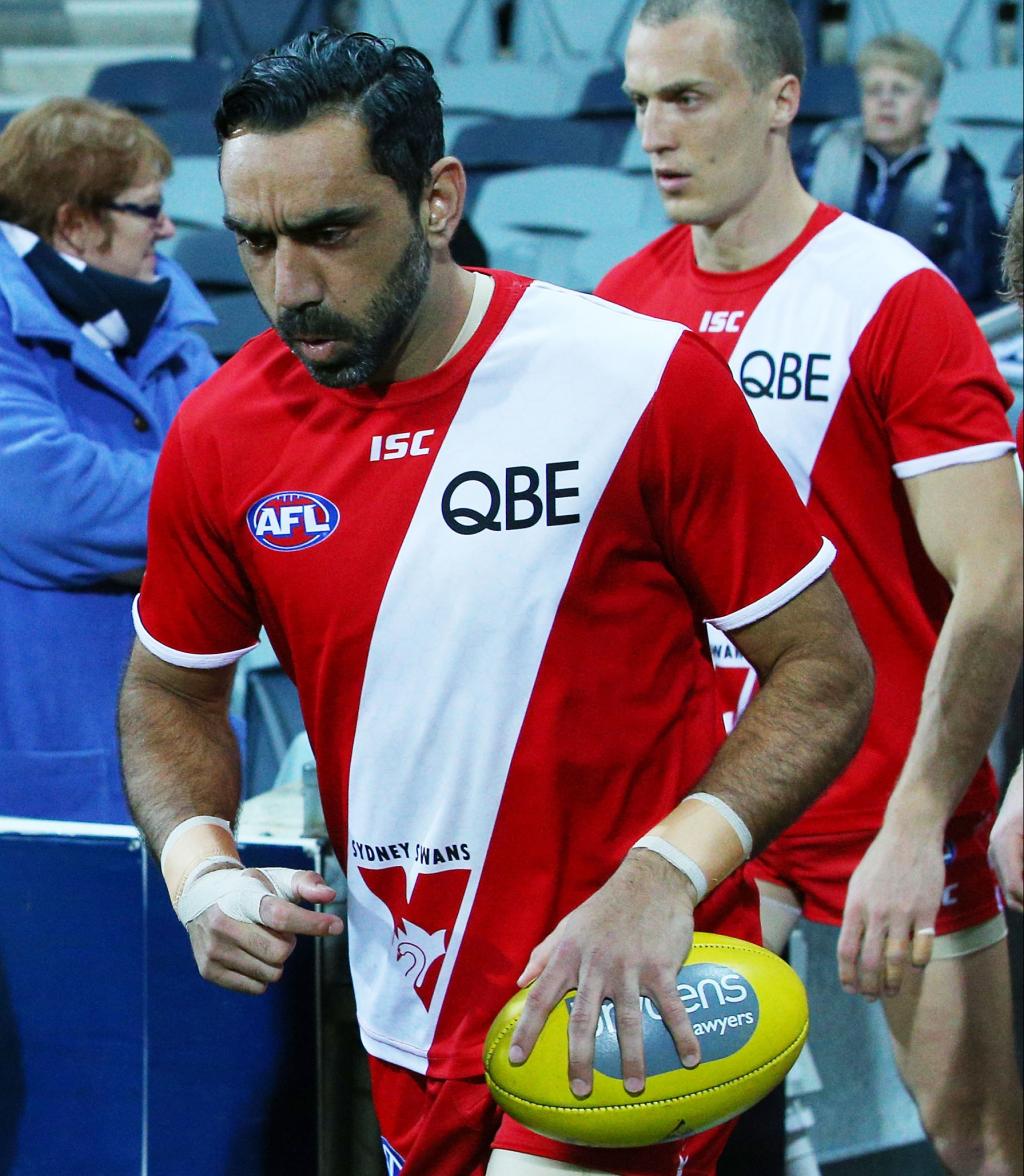
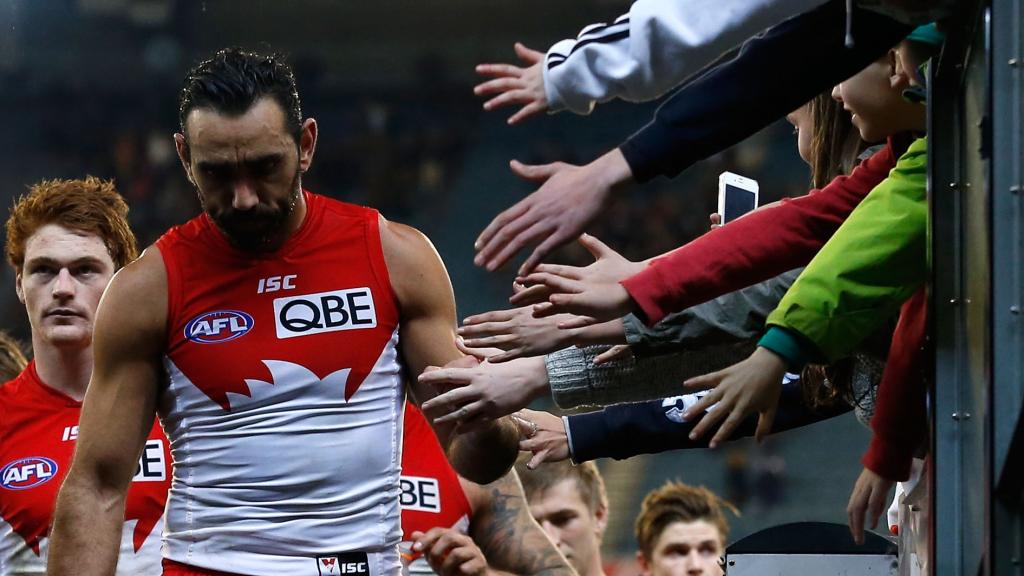
Throughout this dispiriting saga, Goodes kept his own counsel, his only interview of the period given to University of Sydney student newspaper Honi Soit. Michael O'Loughlin did, however, offer clarification about the dance done by Goodes at the SCG. Goodes, O'Loughlin explained, had been miming not the hurl of a spear, but the downward thrust of a heavy boomerang – and it was intended as no more or less than an Australian equivalent of the haka, a statement of pride in which all Australians could hopefully one day participate. Demonstrating both an insight and a gentle humour woefully lacking throughout the affair, O'Loughlin concluded: "It was a very special moment in this country. The only problem is Adam can't dance to save himself, but I would give him 10 out of 10 for effort."
Andrew Mueller's 'Carn: The Game, and the Country that Plays it' is published by HarperCollins Australia and now available in all good bookstores and online. Find the book here.
The documentary special 'The Final Quarter', about Adam Goodes, airs in Australia on Thursday, July 18 on Channel 10.
Read more
SOMETIMES YOU'VE GOT TO STEP UP How Michael Long found his vision
DEREK PEARDON Our mum got three years hard labour
WATCH Australia's most remote local league


